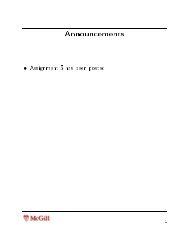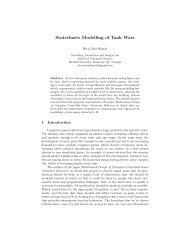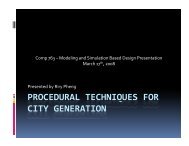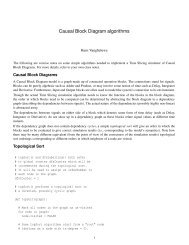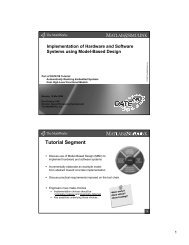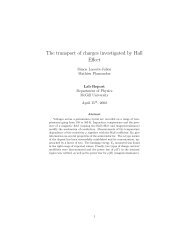Class Diagrams - MSDL
Class Diagrams - MSDL
Class Diagrams - MSDL
Create successful ePaper yourself
Turn your PDF publications into a flip-book with our unique Google optimized e-Paper software.
<strong>Class</strong> <strong>Diagrams</strong><br />
UML
■ <strong>Class</strong>es consist of<br />
the class name<br />
written in BOLD<br />
“features”<br />
attributes and methods<br />
user-defined constraints<br />
■ Note that class diagrams<br />
contain only classes, not<br />
objects.<br />
<strong>Class</strong> Diagram
■ Here is a concrete<br />
example of a class called<br />
Point, which depicts a 2D<br />
point.<br />
■ There are no constraints<br />
(yet...)<br />
■ A class name is written in<br />
UpperCamelCase<br />
<strong>Class</strong> Example
■ A set of prefixes for attributes and methods<br />
+ public – visible to instance of any class<br />
# protected – visible to instances of any subclass<br />
– private – visible only to instances of the class itself<br />
~ package – visible to instance of any class<br />
within enclosing package<br />
Visibility<br />
■ Visibility is a class feature. It is found only in class<br />
diagrams and is enforced statically (at compile-time).
Visibility
■ In UML, inheritance<br />
syntax: a line with a<br />
hollow arrow.<br />
■ In this case, Cube is a<br />
Rectangle (good design).<br />
Inheritance
■ In UML, interfaces are used to represent<br />
require/provide relationships<br />
Interfaces
■ Interfaces allow specification of<br />
a realization of requires/provide<br />
relation.<br />
■ Interfaces describe a contract<br />
between the class and the<br />
outside world.<br />
■ This contract is enforced at<br />
build time by the compiler.<br />
all methods defined by that<br />
interface must be implemented by<br />
the class.<br />
■ UML: stereotype<br />
Interfaces<br />
Note: stereotype and profile are<br />
UML's extension mechanisms
■ Abstract methods (in italic):<br />
no implementation given<br />
can not instantiate<br />
■ <strong>Class</strong> with at least one<br />
abstract method:<br />
Abstract <strong>Class</strong>.<br />
■ Inherit from Abstract <strong>Class</strong><br />
and implement the abstract<br />
methods.<br />
Abstract Members
■ As we saw with genericity,<br />
Templates are a<br />
mechanism to<br />
“parametrize” the types of<br />
objects in class/method<br />
definitions.<br />
■ In UML, they are defined<br />
with a box in the upper<br />
right corner of the class.<br />
Templates
■ A package allows grouping model elements.<br />
Package<br />
■ Can be used for all UML constructs. Most common for<br />
<strong>Class</strong> <strong>Diagrams</strong> and Use Case <strong>Diagrams</strong>.<br />
■ <strong>Class</strong>es and objects in package have a prefix:<br />
<strong>Class</strong>Name::PackageName<br />
objectName:<strong>Class</strong>Name::PackageName<br />
■ A package may (hierarchically) contain other packages.
Components
<strong>Class</strong> Attributes<br />
■ <strong>Class</strong> Attibutes aka static members (either attributes or<br />
methods) exist at the class level.<br />
■ Only one unique value across all instances of the class.<br />
■ They can be used without instantiating an object.<br />
■ UML syntax: underlined (why?).
■ Arrows in UML can have<br />
different meaning.<br />
■ Hollow arrows describe an<br />
inheritance relation.<br />
■ Closed arrows are used to<br />
describe associations.<br />
■ Diamond arrows define<br />
composition relations.<br />
Arrows
■ annotations put over<br />
arrows in class diagrams to<br />
specialize their meaning.<br />
Annotations
Special Inheritance Relations<br />
■ We can use stereotype relations to better define the type<br />
of inheritance.<br />
■ The three attributes are<br />
Disjoint or Overlapping<br />
Complete or Non-complete<br />
Dynamic or Static<br />
■ These attributes are best understood using set theory.<br />
Dog<br />
Cat<br />
Animal
Animal Example
Vehicle Example
Employee Example
Implementation<br />
■ Employees can get promotion and become managers.<br />
■ Employees can get demoted and become non-managers.<br />
■ How would you implement this change?
Non-Manager to Manager<br />
■ How do we implement the dynamic change of a Non-<br />
Manager becoming a Manager?<br />
■ Option A: Create new object Manager. Copy fields.<br />
Destroy old object Non-Manager.<br />
■ Option B: Flag if Manager or not. So we only need an<br />
object employee and it contains all the attributes for Non-<br />
Manager and Manager.
Association<br />
■ Associations describe which/how classes interact which<br />
each other.<br />
You can give an association a name (always a noun)<br />
A full black arrow next to a name indicates the direction the<br />
diagram can be read.<br />
You can put roles at the end of connectors.<br />
You can also put numbers to indicate cardinality.
■ One-to-one<br />
■ Many-to-one or One-to-many<br />
■ Many-to-many<br />
Cardinality of Associations
Employee Example
Association <strong>Class</strong><br />
■ Used to represent associations which contain information.
■ Person object has a reference to dog object(s).<br />
■ Dog object has a reference to person object.<br />
■ Both objects have references to each other.<br />
Navigation<br />
■ This relates to performance (at the cost of space).
Association, in whole or in part<br />
Two special types of associations exists:<br />
■ Composition<br />
■ Aggregation
Scenario 1<br />
■ You can find books in a<br />
bookcase.<br />
Which is which?<br />
Scenario 2<br />
■ You can find shelves in a<br />
bookcase.
Aggregation<br />
■ Aggregate (whole) object can exist without aggregands<br />
(parts).<br />
■ Objects may be part of multiple aggregates.<br />
■ Often, components are of the same type.<br />
■ Shared
Composition<br />
■ A composite object does not exist without its components.<br />
If we delete a composite object, we could use cascading-delete<br />
to remove it and its components.<br />
■ Often, components are of different types<br />
■ Each component is a part of a single composite.



